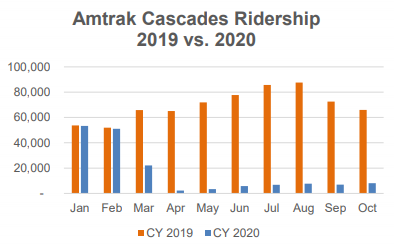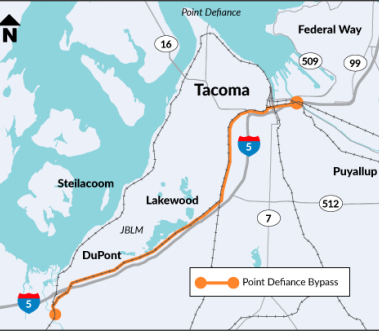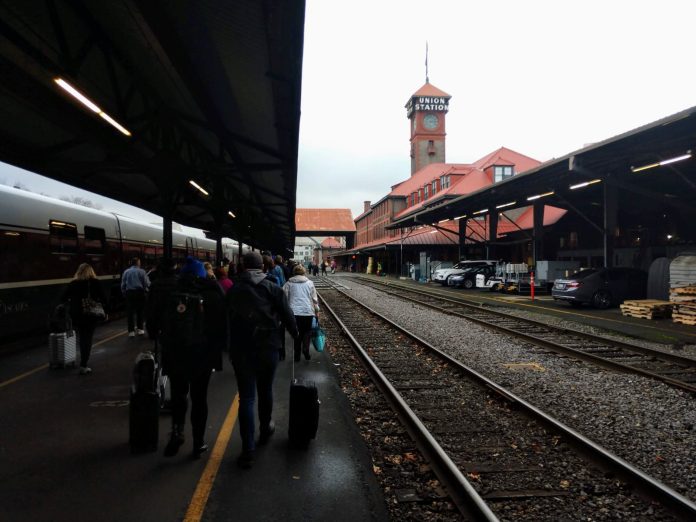New trainsets and return to the Point Defiance Bypass have now made their way on to Amtrak Cascades‘ timetable. On November 30th, Jason Biggs of Washington State Department of Transportation (WSDOT) presented these updates and older developments for the passenger train corridor to the Washington State Legislature’s House Transportation Committee. Covid-19 has ravaged the Cascades corridor and was the main focus of the presentation.
Given that we’re nearly a year into the pandemic, much of the presentation’s information was old. In The Urbanist’s July update, Stephen Fesler reported on 90% lower ridership for the corridor caused in part by service reduction and 50% seating capacity. Closure of the Canadian border suspended Amtrak Cascades service between Seattle and Vancouver, British Columbia. Of the corridor’s 18 stations, only 12 between Seattle and Eugene are being serviced; there’s only one daily trip for each direction today.
Pandemic ridership and protocols are elaborated on in the presentation. Since we last checked in on the numbers, a small recovery in ridership and revenue has appeared. The numbers become somewhat stronger when it comes to percentages compared to last year’s numbers. 2019 had been a record year for ridership and revenue, and WSDOT was hoping to match that record this year. For the remaining service, WSDOT has implemented pandemic protocols on the trains with half capacity, free masks and hand sanitizer, no food and baggage service, daily deep cleaning, cashless ticketing, and waived cancellation fees.

The big news was on a window of opportunity to return to the Point Defiance Bypass from spring to summer 2021. Amtrak activity on the bypass will occur shortly after the New Year with testing that have Amtrak trains run the length of the Bypass, signal test, and give Amtrak crews experience with the territory. Amtrak, WSDOT, and Sound Transit will all be conducting outreach to communities along the Bypass before service is restarted on the track.
As the owner of the stretch of rail, Sound Transit has a Safety Management System that is treating this return as a “new start”, putting Amtrak through a robust set of criteria. Amtrak has been complying with the agency, giving WSDOT strong confidence that Amtrak will return to the Bypass by summer 2021. The corridor currently uses the shoreline route instead of the Bypass, the maiden voyage of which for Amtrak ended in tragic derailment in 2017, and paused Amtrak’s usage of the Bypass since.

As articulated in our past coverage on Amtrak Cascades, the service is using two Talgo Series 8 trainsets owned by the Oregon Department of Transportation (ODOT), and two Horizon Series trainsets from Amtrak. WSDOT doesn’t have its own passenger trains for the corridor. This depleted inventory comes after the retirement of the Talgo Series 6 trainsets, all of WSDOT’s trainsets used for Amtrak, this past June. The National Transportation Safety Board recommended that the model be retired when the cars were deemed unsafe in 2019 for failing crashworthiness standards and other operating safety guidance.
The reduced inventory came during pandemic-reduced service, so when the pandemic ends the corridor will need more trainsets to return to pre-pandemic levels of service. Since we last addressed the topic, Amtrak has presented WSDOT with two interim equipment options: Talgo Series 8 lease and maintenance and use Amtrak-owned equipment. Using Amtrak-owned equipment, more Horizon Series trainsets, is the significantly cheaper option and seemed the most appealing to WSDOT. When Amtrak is able to give final details on the Horizon Series equipment, WSDOT and ODOT will be able to finalize operating and equipment plans.
Also announced in the update was WSDOT’s anticipation of a 2025 delivery for new replacements. Amtrak has committed to give WSDOT the first of the new trains that will be procured in a national 10-state-plus Amtrak procurement package. A manufacturer has not been selected yet. For the new trains and in light of the pandemic, WSDOT and Amtrak are exploring modern filtration systems for the new trains. Old information on new equipment includes funding for at least three new trainsets, around half coming from a $37.5 million federal grant, and the other half coming from $25 million of derailment insurance proceeds and up to $12.5 million in state funding–$10 million of which has been set aside in the 2019 biennium.
With the end of the pandemic and a potentially rail-friendly Biden administration in sight, there is much to hope and push for on rail infrastructure and service. With the slew of good vaccine news, wide vaccination for Covid-19 could be achieved by the summer of 2021 and set up Amtrak Cascades for a strong year back to regular service in 2022. For high-speed rail, The Urbanist has written on Biden’s ambitious goals and the president-elect’s thinking on a connected national network as economic stimulus. Perhaps Cascadia high-speed rail will be more than just a few studies soon.
Shaun Kuo is a junior editor at The Urbanist and a recent graduate from the UW Tacoma Master of Arts in Community Planning. He is a urban planner at the Puget Sound Regional Council and a Seattle native that has lived in Wallingford, Northgate, and Lake Forest Park. He enjoys exploring the city by bus and foot.


